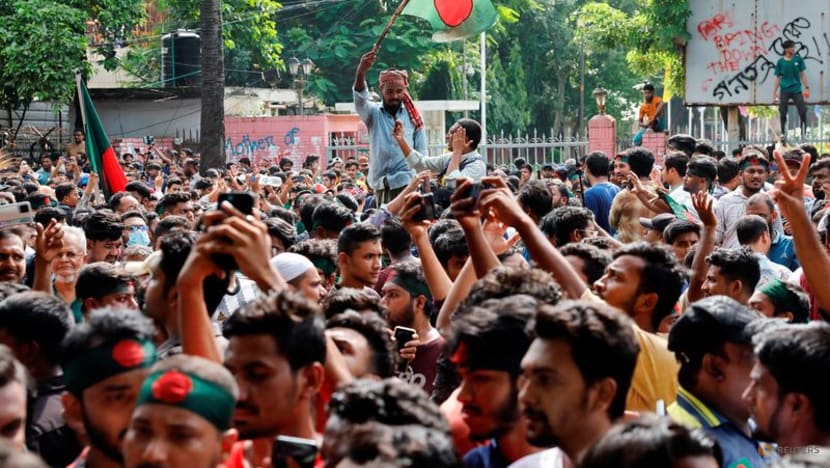CNA Explains: How protests in Bangladesh led to Sheikh Hasina resigning and fleeing
More than 300 people have been killed since protests began over a jobs quota, with thousands arrested.

People celebrate the resignation of Prime Minister Sheikh Hasina in Dhaka, Bangladesh, August 5, 2024. REUTERS/Mohammad Ponir Hossain

This audio is generated by an AI tool.
Political uncertainty shrouds Bangladesh after the country’s Prime Minister Sheikh Hasina resigned and fled the country in a culmination of weeks of deadly unrest, ending her 15-year rule.
On Monday (Aug 5), hundreds of demonstrators stormed and ransacked Hasina’s official residence. Protesters also pummeled a statue of Hasina’s father Sheik Mujibur Rahman, the country's founder, while others set a museum dedicated to him on fire.
More than 300 people have been killed since protests began. Thousands were also arrested.
Bangladeshi President Mohammed Shahabuddin late on Monday ordered the release of prisoners from the protests, as well as former prime minister and key opposition leader Khaleda Zia, 78.
The military has said it would form an interim government. The student movement that set the chain of events in motion said it would propose an outline for the new interim government.
Bangladesh's Nobel-winning economist and banker Muhammad Yunus will lead an interim government, Shahabuddin's office announced on Wednesday.
The appointment came shortly after student leaders called on the 84-year-old Yunus - credited with lifting millions out of poverty in the South Asian country - to lead.
Why did the protests start?
In June, the High Court of Bangladesh reinstated a quota that reserves 30 per cent of government jobs for children of the veterans of Bangladesh's 1971 independence war.
This came after a group of veterans’ relatives filed a written petition urging the court to reapply the quota.
This quota was previously in place and rescinded by the government in response to massive student protests in 2018.
A further 26 per cent of jobs were allocated to women, disabled people and ethnic minorities. This left about 3,000 positions that 400,000 graduates would have to compete for in the civil services exam in a country where unemployment is rampant.
Latest figures released by Bangladesh authorities in May showed that about 2.6 million individuals were unemployed.
Students began protesting the reinstatement, arguing that the quota system was discriminatory and benefited supporters of Hasina’s Awami League party, which led the independence movement.
Why did the protests escalate?
While the protests were initially peaceful, they turned violent as security officials and pro-government activists dispersed tear gas and fired rubber bullets.
Rallies across the nation intensified after Hasina referred to the protesters as “razakars”, which refers to people who collaborated with Pakistan during the 1971 war.
Hasina addressed the nation and announced a judicial probe after people died following the clashes. The government then restricted the internet, putting in place a communication blackout.
Police said protesters vandalised property and torched government buildings, including a national television station.
On Jul 19, the government imposed a curfew with a shoot-on-sight order. However, students defied the curfew.
Amid the protests, curfew and internet shutdown, the Supreme Court on Jul 21 issued an order to reduce the quota from 30 per cent to 5 per cent. It ruled that 93 per cent of jobs would instead be open to candidates on merit.
However, the protests continued as students and other citizens assembled with a new purpose, calling for Hasina to step down.
“It seems at the point that the court finally ruled in favor of what the protesters were asking, things had run away,” said Professor Greg Barton, chair of global Islamic politics at Deakin University.
What led to Hasina's resignation?
Barton noted that Hasina’s 15 years of rule were marred with concerns about election fraud, corruption, nepotism and authoritarian crackdowns.
“There generally seemed to be a democratic backsliding. So there were lots of deep-rooted causes for anger, of which the civil service quota was just one,” he said.
Barton said it was “not surprising” that Hasina was “ultimately forced to resign”, but given that she began her fourth consecutive term earlier this year, her resignation was not certain from the outset.
Nusrat Chowdhury, associate professor of anthropology and sociology at Amherst College, said it was obvious to observers and residents that things could not go back to the way they were.
This was due to the violence that has gripped the country in the past two weeks, as well as “the way in which the government seemed really out of touch with what the protesters were wanting”, she said.
“At the same time, I think many of us were surprised at the haste in which the events have unfolded,” Chowdhury noted.
With the quota movement being described as a “spark that started the fire”, she pointed out that a long history and “cumulative effect of grievances and resentment” were expressed through the recent protests.
What’s next?
Yunus, a well-known critic of Hasina, will lead the interim government.
There is “no better person in the world” for the job, said adjunct professor Lutfey Siddiqi from the National University of Singapore’s Business School.
He noted that Yunus' career has been about business, innovation, creativity, startups and execution, describing him as a "business builder".
He added that Yunus will have to form a team and make them gel quickly.
"The economy is not going to wait for the country to resolve ideological battles, or even complete the whole process of depoliticising institutions," he said.
"We need to get to work as quickly as possible and get into execution mode."
However, Amit Ranjan, research fellow at the National University of Singapore’s Institute of South Asian Studies, expressed concern over the how decisive Yunus' voice will be and how long the interim government will run.
"The first major step he should take is to restore the normalcy in the country. Unless peace and law and order are established, it will be very difficult for any government to run the country," he told CNA's Asia Now.
















